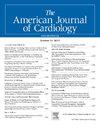The Safety and Effectiveness of Slow Pathway Region Visualization Strategy in Radiofrequency Ablation for Adults With Atrioventricular Nodal Reentry Tachycardia: A Multicenter Retrospective Study
IF 2.3
3区 医学
Q2 CARDIAC & CARDIOVASCULAR SYSTEMS
引用次数: 0
Abstract
Targeting the atrioventricular nodal slow pathway (AVNsp) is the standard treatment in catheter ablation procedures for atrioventricular nodal reentrant tachycardia (AVNRT). However, significant anatomical variability in Koch's triangle poses challenges for precise ablation and increases the risk of atrioventricular block (AVB). Previous studies have reported that the AVNsp visualization strategy reduces the incidence of AVB, however, these studies were conducted in pediatric patients or with the energy of cryoablation. However, the safety and effectiveness of this strategy in adults undergoing radiofrequency ablation (RFA) remains unclear. This study aimed to evaluate the safety and effectiveness of high-density mapping (HDM)-guided AVNsp visualization strategy for AVNRT ablation compared to the conventional approach. We retrospectively analyzed data from 149 AVNRT patients across 3 hospitals in China. Patients were divided into 2 groups: experimental group (i.e. treated with the HDM-guided AVNsp visualization strategy, n = 88) and control group (i.e. treated with the traditional mapping and ablation strategy, n = 61). Procedural parameters, complication rates, and long-term outcomes were compared. The experimental group required fewer ablation points (4.8 ± 3.6 vs 8.5 ± 7.7, p = 0.003), shorter total ablation time (284 ± 178 s vs 408 ± 345 s, p = 0.028), and reduced procedure time (41.4 ± 14.2 min vs 51.5 ± 27.2 min, p = 0.009) compared with the control group. No cases of AVB occurred in the experimental group, while the control group reported 5 (8.2%) transient AVB and 1 (1.6%) persistent first-degree AVB after procedure. After a mean follow-up of 488 ± 246 days, no recurrences of AVNRT were observed in either group. In conclusion, for adult patients with AVNRT, the AVNsp visualization strategy enhances the safety and effectiveness of RFA by reducing procedure time and minimizing the risk of AVB.
慢路径区域可视化策略在成人房室结型再入性心动过速射频消融中的安全性和有效性:一项多中心回顾性研究。
靶向房室结慢通路(AVNsp)是房室结折返性心动过速(AVNRT)导管消融的标准治疗方法。然而,科赫三角显著的解剖变异为精确消融带来了挑战,并增加了房室传导阻滞(AVB)的风险。先前的研究报道了AVNsp可视化策略降低了AVB的发生率,然而,这些研究是在儿科患者中进行的或与冷冻消融能量一起进行的。然而,该策略在接受射频消融(RFA)的成人中的安全性和有效性尚不清楚。本研究旨在评估高密度定位(HDM)引导下AVNsp可视化策略在AVNRT消融中的安全性和有效性,并与传统方法进行比较。我们回顾性分析了来自中国三家医院的149例AVNRT患者的数据。将患者分为两组:实验组(采用hdm引导下AVNsp可视化策略,n=88)和对照组(采用传统定位消融策略,n=61)。比较手术参数、并发症发生率和长期结果。与对照组相比,实验组需要更少的消融点(4.8±3.6 vs 8.5±7.7,P=0.003),更短的消融时间(284±178s vs 408±345s, P=0.028),更短的手术时间(41.4±14.2min vs 51.5±27.2min, P=0.009)。实验组无AVB发生,对照组术后短暂性AVB 5例(8.2%),持续性一级AVB 1例(1.6%)。平均随访488±246天,两组均未见AVNRT复发。总之,对于成年AVNRT患者,AVNsp可视化策略通过减少手术时间和最小化AVB风险来提高RFA的安全性和有效性。
本文章由计算机程序翻译,如有差异,请以英文原文为准。
求助全文
约1分钟内获得全文
求助全文
来源期刊

American Journal of Cardiology
医学-心血管系统
CiteScore
4.00
自引率
3.60%
发文量
698
审稿时长
33 days
期刊介绍:
Published 24 times a year, The American Journal of Cardiology® is an independent journal designed for cardiovascular disease specialists and internists with a subspecialty in cardiology throughout the world. AJC is an independent, scientific, peer-reviewed journal of original articles that focus on the practical, clinical approach to the diagnosis and treatment of cardiovascular disease. AJC has one of the fastest acceptance to publication times in Cardiology. Features report on systemic hypertension, methodology, drugs, pacing, arrhythmia, preventive cardiology, congestive heart failure, valvular heart disease, congenital heart disease, and cardiomyopathy. Also included are editorials, readers'' comments, and symposia.
 求助内容:
求助内容: 应助结果提醒方式:
应助结果提醒方式:


